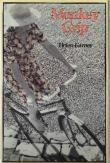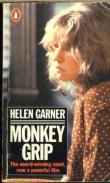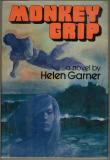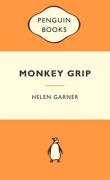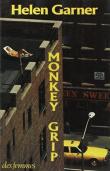
Latest Issues
AbstractHistoryArchive Description
Set in inner suburban 1970s Melbourne, Monkey Grip describes the fluid relationships of a community of friends who are living and loving in new ways. Single parent Nora falls in love with Javo, a heroin addict, and together they try to make sense of their lives and the choices they have made.
Adaptations
-
form
y
 Monkey Grip
( dir. Ken Cameron
)
1982
Australia
:
Pavilion Films
,
1981
Z820614
1982
single work
film/TV
(taught in 1 units)
Monkey Grip
( dir. Ken Cameron
)
1982
Australia
:
Pavilion Films
,
1981
Z820614
1982
single work
film/TV
(taught in 1 units)
Set in inner Melbourne over two summers, Monkey Grip is a frank portrayal of a divorced mother who is attempting to cope with both her thirteen-year-old daughter and her own relationship with a drug addict, while also trying to get into the music business. As she battles to regain control of her life, we meet an array of talented and reckless musicians, actors, and writers, all of whom play a part in her world and most of whom refuse to live by society's rules.
Publication Details of Only Known VersionEarliest 2 Known Versions of
Other Formats
- Also sound recording.
- Large print.
Works about this Work
-
Helen Garner’s House of Fiction
2023
single work
criticism
— Appears in: The Cambridge Companion to the Australian Novel 2023; (p. 163-177)'This chapter considers Helen Garners fiction, assessing the evolution of her work from the scandalous diary-like immediacy of the Monkey Grip (1977) through to her minimalist masterpiece The Children’s Bach (1984). Throughout, it considers the house as a core spatial configuration that changes across Garner’s work.' (Publication abstract)
-
Weird Is In
2023
single work
essay
— Appears in: Kill Your Darlings [Online] , May 2023;'Australian fiction has long been dominated by the realist novel. A new wave of writers continue the avant-garde tradition—but are experimental and offbeat stories always destined to be relegated to a literary niche? '
-
Helen Garner, Robert Hughes and the Mystery of Nonfiction
2022
single work
essay
— Appears in: Meanjin , December vol. 81 no. 4 2022; (p. 196-208)'It's 45 years since Helen Garner published Monkey Grip and perhaps a while later that people realised how fine a writer she was. In 1997 there was that shock of recognition that someone had succeeded in re-creating inner-urban Melbourne, the 'aqua profunda' part of the Fitzroy pool, the tumult and tumbling from bed to bed of shared housing, the heartache of loving a junkie. The initial response to Monkey Grip was a response to a literary brave new world that was also the translation of something real. Indeed, there were critics such as the late Peter Pierce who said that Helen Garner had just talked dirty and called it realism. Yes, and along with this, there was the persistent accusation that she had simply published her diaries and served them up as fiction. This last point had come to seem like the most vulgar misprision by the time I wrote a full-dress defence of Garner in Judith Brett's Meanjin in the mid 1980s.' (Publication abstract)
-
Where Is Easey Street? Reading Garner’s Monkey Grip Today
2022
single work
column
— Appears in: Overland [Online] , July 2022;'The city of Melbourne churns at the centre of Helen Garner’s Monkey Grip, sustaining the plot of a book lauded as the ‘quintessential Melbourne novel.’ The streets of the inner north on which the story unfolds still exist: Delbridge Street down through the ‘green tunnel’ of Edinburgh Gardens still leads to Fitzroy Baths where one might still dive into the cool blue ‘aqua profonda.’ Yet they also never existed.' (Introduction)
-
Helen Garner’s Education
2021
single work
criticism
— Appears in: Australian Literary Studies , October vol. 36 no. 3 2021; 'On the 14th of December 1972, a schoolteacher named Helen Garner found herself fired. This essay argues that the terms of Garner’s firing inform the countercultural realism of her first novel Monkey Grip (1977), which is unabashedly fluent in, and indeed narratively yearns for, various forms of the four-letter contraband that got her sacked in the first place. I go on to show how her subsequent hiring by various universities in a succession of writer-in-residencies left related yet distinct marks on her taut minimalist masterpiece, The Children’s Bach (1984). My claim is that Garner’s firing therefore ironically heralds the belated emergence of a period of Australian literary history in which the new diversity of literary fiction cannot be fully comprehended, as Mark McGurl argues in his seminal study of postwar American fiction The Program Era (2009), without close attention ‘to the increasingly intimate relation between literary production and the practices of higher education’ (ix).' (Publication abstract)
-
First Impressions : The Critical Archives
2003
single work
review
— Appears in: The Age , 1 November 2003; (p. 2)
— Review of Monkey Grip 1977 single work novel -
Monkey Grip
1978
single work
review
— Appears in: Womanspeak , March-April vol. 3 no. 5 1978; (p. 29)
— Review of Monkey Grip 1977 single work novel -
[Review] Monkey Grip
1978
single work
review
— Appears in: Luna , vol. 3 no. 1 1978; (p. 42)
— Review of Monkey Grip 1977 single work novel -
Books of the Week
2012
single work
review
— Appears in: The Sunday Mail , 30 September 2012; (p. 37)
— Review of Monkey Grip 1977 single work novel -
The Books That Made Us
1995
single work
review
— Appears in: The Weekend Australian , 19-20 August 1995; (p. rev 1-2)
— Review of My Brother Jack : A Novel 1964 single work novel ; The Lucky Country 1964 single work non-fiction ; Joe Wilson and His Mates 1901 selected work short story ; My Brilliant Career 1901 single work novel ; Monkey Grip 1977 single work novel ; Voss : A Novel 1957 single work novel ; The Fortunes of Richard Mahony 1917 single work novel -
Traffic
i
"The traffic is heavy today and the going's uphill. This is the",
1988
single work
poetry
— Appears in: Telling Ways : Australian Women's Experimental Writing 1988; (p. 53) Wordhord : A Critical Selection of Contemporary Western Australian Poetry 1989; (p. 236) -
Coming Clean in an Ocean of Grey
2003
single work
column
— Appears in: Canberra Sunday Times , 12 October 2003; (p. 19) -
Mother & Child Reunion
2006
single work
biography
— Appears in: The Age , 19 August 2006; (p. 12-13) The Sydney Morning Herald , 19-20 August 2006; (p. 8-9) -
Hard Hearts, Tender Years
2006
single work
essay
— Appears in: The Age , 7 October 2006; (p. 5) -
Sex in the City : Sexual Predation in Contemporary Australian Grunge Fiction
2007
single work
criticism
— Appears in: Aumla , May no. 107 2007; (p. 145-158) 'This essay will focus on the sexuality of grunge fiction characters, and will examine the relationship of this focus to issues of embodiment, culture and urban spaces' (146).
Awards
- 1978 joint winner National Book Council Award for Australian Literature
- Melbourne, Victoria,
- 1970s
